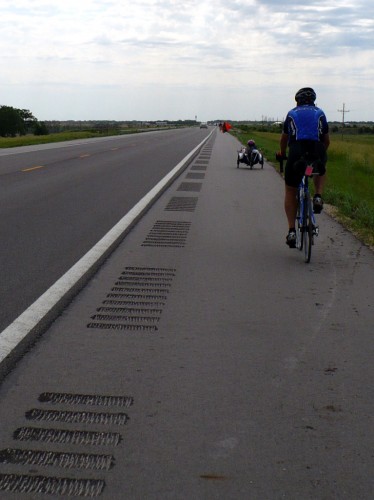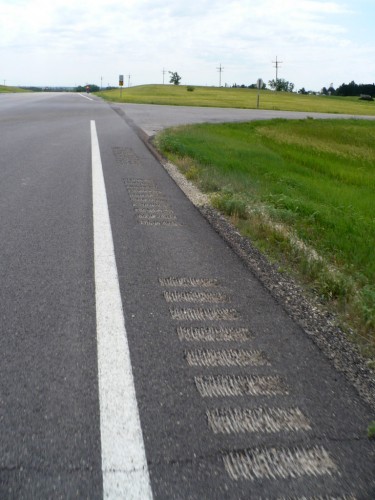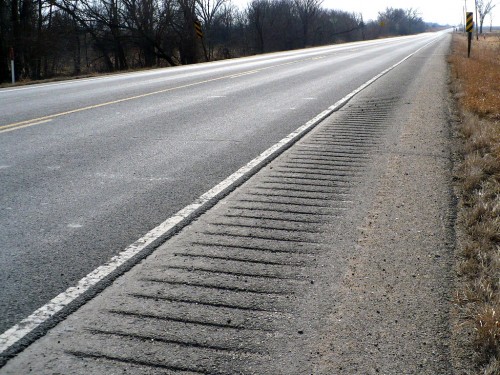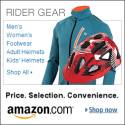Recently, the League of American Bicyclists has been raising awareness about national rumble strip policy, and the sometimes-alarming loss of bicycle-friendly roads due to ill-conceived rumble strip designs:
What are rumble strips?: Rumble strips are raised or grooved patterns in a road’s shoulder designed to alert drivers with noise and vibrations that they are drifting off the roadway.i They can be an effective safety measure to prevent run-off-the-road (ROR) crashes, especially on limited‐access highways and rural two-lane highways with long straight sections.(Rumble strips placed on the centerline can help prevent head-on crashes.)
How do rumble strips impact cyclists?: Rumble strips are virtually impossible to ride a bicycle on or over — they are at best uncomfortable, even for a very short distance, and at worst can cause a cyclist to lose control of their bike and fall. They can damage a bicycle wheel, can cause a flat tire, and/or shake lose parts off a bicycle. Consequently, cyclists will avoid riding over them — and when rumble strips leave no room on a shoulder, the cyclist will have no other option than to ride in the travel lane. While rumble strips do not deter car, truck or bus travel, they have a severe impact on bicycling travel, and have ruined popular cycling routes.
The League has produced a report, Bicycling and Rumble Strips, that goes into detail about the problem, national standards, and suggested solutions.
See also: Rumble Strips: Problems and Policies, and Act Now to Save Riding Routes From Rumble Strips!
The League also provides a handy Take Action page that provides links that allow cyclists to directly contact their state DOT and express their concern about rumble strip policies.
It’s really easy — the text of the mesage is already pre-populated (but you can edit it to personalize or discuss specific roads), and all you need to do is fill in in your contact information and click “Send”. Here’s the direct link to Kansas Department of Transportation Secretary Deb Miller.
Rumble strips are a particularly important issue in Kansas, because we have so many miles of rural highways — the second-largest highway system in the country. Once a road is widened or resurfaced, and rumble strips are added, we’ll be stuck with them for a long time, a decade at least. So it’s important to make sure that the state realizes the negative impact poorly-designed rumble strips can have on bicycle traffic.
So please, contact KDOT with your concerns.
I did so a few weeks ago, and here’s the response I received from Secretary Miller:
The Kansas Rumble Strip Policy was last revised in 2007. It included the following statement relevant to bicyclists: “A minimum 3 ft paved area outside of the shoulder rumble strip should be provided for bicyclists on highway routes on the American Discovery Trail Route, Trans America Route and other Suggested Cross State Bicycle Routes per the latest edition of the Kansas Bicycle Guide.” Our standard detail for shoulder rumble strips also addresses many concerns of the bicycle community: The strips are narrow at 16 inches; deep enough to be effective with a maximum depth of 5/8-inch; installed 6 inches off the white edgeline; and installed in a 10-foot/5-foot rumble/gap pattern. These rumble strip details help the Kansas Department of Transportation (KDOT) reach the goals stated in our Strategic Highway Safety Plan (SHSP) while also making conditions more favorable for bicyclists.
In 2006, we established our SHSP, with the goal of reducing annual traffic fatalities to less than 365 by 2010. In that plan, roadway departure crashes were identified as a significant contributor to fatal and serious injury crashes. Rumble strips-both shoulder and center-line-were then identified as a key strategy to address the problem. Shoulder rumble strips are a proven countermeasure to reduce the potential for run-off-road crashes. Because these crashes are difficult to predict, many states, including Kansas, install rumble strips systematically based on policy and standards rather than waiting for a problem to develop at a particular location. In Kansas, rumble strips are used on all rural highways having full-width (8 feet or greater) paved shoulders. For highways with less than an 8-foot shoulder, their use is based on an engineering study or at the discretion of our District Engineers. We no longer install rumble strips on urban highways.
At KDOT we continually work towards addressing the needs of the bicycle community as part of our mission: to provide a statewide transportation system to meet the needs of Kansas. If there are any specific highway routes or projects you would like to discuss, please contact Steve Buckley, KDOT State Highway Safety Engineer at (785) 296-1148 or by email at Buckley@ksdot.org .
So the good news is that Kansas does have a Rumble Strip Policy (though it doesn’t appear to be online), and its guidelines are fairly reasonable (though could stand to be improved).
Here are a few examples of Kansas rumble strips:

This is an example of an excellent shoulder and a decent rumble strip that meets the KDOT guidelines. This is from somewhere on Highway 36 in western Kansas (a suggested cross-state bicycle route).

This is a not-so-nice rumble strip example — there’s almost nowhere on the shoulder for a bicycle to ride. This is from somewhere on Highway 24 in central Kansas (not a suggested cross-state bicycle route).

This is another bicycle-unfriendly rumble strip — the rumbles are continuous, take up half the width of the shoulder, and the remainder of the shoulder is filled with debris. This is from Highway 56 near Gardner (not a suggested cross-state bicycle route).
What are rumble strips like in your area?



I vibrated loose a taillight screw on K-254 outside of El Dorado–full-width rumble strip. No room to the right of it.
If the state wants cyclists to use the shoulder, may I suggest 1-2 times a month sweeping, and always after accidents? Fat kevlar/vectran tires work fine over the road-spewed crap and rubble strip. Skinny road tires, not so much.